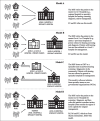Pilot Implementation of a Community-based, eHealth-enabled Service Delivery Model for Newborn Hearing Screening and Intervention in the Philippines
- PMID: 39483802
- PMCID: PMC11522630
- DOI: 10.47895/amp.v57i9.5332
Pilot Implementation of a Community-based, eHealth-enabled Service Delivery Model for Newborn Hearing Screening and Intervention in the Philippines
Abstract
Objectives: This study explores the potential of the HeLe Service Delivery Model, a community-based newborn hearing screening (NHS) program supported by a web-based referral system, in improving provision of hearing care services.
Methods: This prospective observational study evaluated the HeLe Service Delivery Model based on records review and user perspectives. We collected system usage logs from July to October 2018 and data on patient outcomes. Semi-structured interviews and review of field reports were conducted to identify implementation challenges and facilitating factors. Descriptive statistics and content analysis were used to analyze quantitative and qualitative data, respectively.
Results: Six hundred ninety-two (692) babies were screened: 110 in the RHUs and 582 in the Category A NHS hospital. Mean age at screening was 1.4±1.05 months for those screened in the RHU and 0.46±0.74 month for those in the Category A site. 47.3% of babies screened at the RHU were ≤1 month old in contrast to 86.6% in the Category A hospital. A total of 10 babies (1.4%) received a positive NHS result. Eight of these ten patients were referred via the NHS Appointment and Referral System; seven were confirmed to have bilateral profound hearing loss, while one patient missed his confirmatory testing appointment. The average wait time between screening and confirmatory testing was 17.1±14.5 days. Facilitating factors for NHS implementation include the presence of champions, early technology adopters, legislations, and capacity-building programs. Challenges identified include perceived inconvenience in using information systems, cost concerns for the patients, costly hearing screening equipment, and unstable internet connectivity. The lack of nearby facilities providing NHS diagnostic and intervention services remains a major block in ensuring early diagnosis and management of hearing loss in the community.
Conclusion: The eHealth-enabled HeLe Service Delivery Model for NHS is promising. It addresses the challenges and needs of community-based NHS by establishing a healthcare provider network for NHS in the locale, providing a capacity-building program to train NHS screeners, and deploying health information systems that allows for documentation, web-based referral and tracking of NHS patients. The model has the potential to be implemented on a larger scale - a deliberate step towards universal hearing health for all Filipinos.
Keywords: community healthcare; health information systems; healthcare delivery; hearing loss; newborn screening.
© 2023 Acta Medica Philippina.
Conflict of interest statement
All authors declared no conflicts of interest.
Figures


Similar articles
-
Evaluation of the Design and Development of the HeLe Newborn Hearing Screening Tele-Audiology Systems for the Philippines.Acta Med Philipp. 2023 Sep 28;57(9):60-72. doi: 10.47895/amp.v57i9.5392. eCollection 2023. Acta Med Philipp. 2023. PMID: 39483799 Free PMC article.
-
Assessment of Readiness for a Community-based Teleaudiology Program of Selected Primary Care Health Facilities in the Philippines.Acta Med Philipp. 2023 Sep 28;57(9):85-94. doi: 10.47895/amp.v57i9.4984. eCollection 2023. Acta Med Philipp. 2023. PMID: 39483796 Free PMC article.
-
Health screening clinic to reduce absenteeism and presenteeism among NHS Staff: eTHOS a pilot RCT.Health Soc Care Deliv Res. 2024 Aug;12(23):1-105. doi: 10.3310/KDST3869. Health Soc Care Deliv Res. 2024. PMID: 39192689 Clinical Trial.
-
State programs for universal newborn hearing screening.Pediatr Clin North Am. 1999 Feb;46(1):89-94. doi: 10.1016/s0031-3955(05)70083-3. Pediatr Clin North Am. 1999. PMID: 10079792 Review.
-
Status of the Newborn Hearing Screening in the 4-Months Age National Infant Health Checkup in Korea: A Nationwide Population-Based Study.J Korean Med Sci. 2023 Jan 30;38(4):e29. doi: 10.3346/jkms.2023.38.e29. J Korean Med Sci. 2023. PMID: 36718562 Free PMC article. Review.
References
-
- Santos-Cortez RLP, Chiong CM. Cost-analysis of universal newborn hearing screening in the Philippines. Acta Med Philipp. 2013;47(4):52-7. doi: 10.47895/amp.v47i4.1267. - DOI
-
- World Health Organization . Newborn and infant hearing screening: current issues and guiding principles for action [Internet]. 2010. [cited 2022 Feb]. Available from: https://www.who.int/.
-
- American Speech-Language-Hearing Association (ASHA) . Executive Summary for JCIH Year 2007 Position Statement: Principles and Guidelines for Early Hearing Detection and Intervention Programs [Internet]. [cited 2022 Feb]. Available from: https://www.asha.org/.
LinkOut - more resources
Full Text Sources
